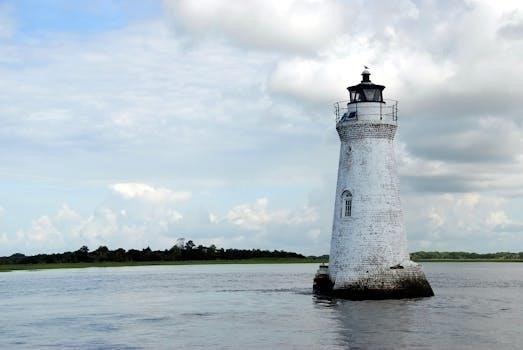Upper Cherry Creek Guide
This guide explores Upper Cherry Creek, located above the Cherry Creek Dam & Reservoir. It highlights access points, trail connections, and opportunities for outdoor activities. Discover the beauty and recreational potential of this scenic area, from hiking to kayaking, with detailed information.
Overview of Upper Cherry Creek
Upper Cherry Creek, a captivating area situated upstream from the well-known Cherry Creek Reservoir, presents a diverse landscape brimming with recreational opportunities. Unlike the urbanized Cherry Creek Trail that traverses the heart of Denver, Upper Cherry Creek offers a more natural and secluded experience, appealing to outdoor enthusiasts seeking respite from the city’s hustle. The area is characterized by a blend of open spaces, wetlands, and gradually evolving residential areas, creating a dynamic environment for exploration.
The Cherry Creek Regional Trail, a key component of the Colorado Front Range Trail, runs parallel to the creek, providing a convenient pathway for cyclists and hikers to delve into the Upper Cherry Creek region. This trail network facilitates connections to various points of interest, including Cherry Creek State Park, where a multitude of trails cater to different skill levels and preferences. Whether you’re looking for a leisurely bike ride, an invigorating hike, or a challenging kayaking expedition, Upper Cherry Creek offers a range of options. The area’s unique blend of accessibility and natural beauty makes it a compelling destination for those seeking to connect with the outdoors.
Location and Access Points
Upper Cherry Creek, situated south-east of Denver, can be accessed via several convenient routes, catering to various modes of transportation. For those arriving by car, parking is available at Philpott Park on W. 37th Place, providing a starting point for exploring the lower sections of the trail. From there, the Cherry Creek Trail extends upstream, offering a scenic journey towards the upper reaches of the creek.
Alternatively, public transportation users can leverage the RTD Light Rail system, specifically the H Line, to reach the County Line Station, located near Park Meadows Mall. From the station, a short southward journey along the frontage road, passing under E-470, leads to the Cherry Creek Trail. This option offers a car-free way to access the trail network. The E-470 trail connection itself provides another access point, although it’s worth noting that this section of the trail can be noisy due to its proximity to the highway. Despite this, it serves as a useful link for reaching other trail systems and exploring the broader Cherry Creek region. The intersection with the Cherry Creek Regional Trail marks a key junction, offering choices to head towards Franktown or Denver.
Cherry Creek Trail⁚ From Franktown to Cherry Creek Dam
The Cherry Creek Trail offers an extensive pathway stretching from Franktown all the way to the Cherry Creek Dam, presenting a diverse recreational experience. While plans are in motion to connect trails further south to Castlewood Canyon State Park, the existing segment provides ample opportunity for exploration. Starting from Franktown, the trail meanders alongside Cherry Creek, showcasing the natural beauty of the surrounding landscape.
As the trail progresses towards the Cherry Creek Dam, it passes through various environments, including wetlands and areas undergoing new development. While some sections may have experienced construction and changes over time, the overall charm of the trail remains intact. Remnants of the past, such as old gates and horse pastures, blend with new townhomes, illustrating the evolving landscape. The trail offers both concrete paths and single-track options, catering to different preferences. Keep in mind that there are sections where you have to exit into a subdivision and go right once you hit the street to Jordan Road. The eventual destination is the Cherry Creek State Park. The journey culminates at the impressive Cherry Creek Dam, offering panoramic views of the reservoir and the surrounding area.

Reaching the Upper Trail⁚ RTD Light Rail Access
For those seeking a car-free option to access the upper reaches of the Cherry Creek Trail, the RTD Light Rail system provides a convenient solution. Specifically, the H Line offers a direct connection to the County Line Station, situated adjacent to Park Meadows Mall, which serves as a gateway to the trail. When utilizing the light rail with a bicycle, it is essential to board at the designated areas at the end of each car. These areas are typically marked on the platform to ensure proper bike placement and passenger safety. Upon arrival at the County Line Station, passengers must exit via the covered bridge that spans over I-25.
From there, proceed out of the parking lot and make a right turn (south) onto the frontage road. After approximately one mile, the road passes underneath E-470, a toll road, and the Cherry Creek Trail becomes visible. This marks the beginning of the upper section of the trail, offering a seamless transition from public transportation to outdoor recreation. Remember to stand with your bike so it doesnt move around.
Navigating the E-470 Trail Connection
The E-470 trail offers a crucial connection for accessing various parts of the Denver trail network, though it may not be the most scenic option. As it parallels the E-470 toll road, users should anticipate consistent highway noise throughout their journey. Despite this, the E-470 trail serves as a practical route to reach other trails.
From the County Line Station, after going under E-470, you’ll find yourself on the E-470 trail. Follow the E-470 trail for approximately five miles until you reach the Cherry Creek Regional Trail. The E-470 trail presents a more challenging ride due to the presence of hills, making it suitable for training purposes. However, riders seeking a more leisurely experience might prefer trails along rivers, creeks, or canals. Be aware that the trail’s condition can vary, particularly after snowfall, with potential substandard plowing. While not the quietest or most picturesque, the E-470 trail remains a valuable link for exploring the wider Denver trail system.
Cherry Creek Regional Trail Junction
The Cherry Creek Regional Trail junction marks a significant point in navigating the Upper Cherry Creek area. Arriving from the E-470 trail, this junction provides clear directional options, allowing users to choose their path towards either Franktown or Denver. This point signifies a shift from the highway-adjacent E-470 trail to the more natural surroundings of the Cherry Creek corridor.
At the junction, Cherry Creek flows on the other side of the tree line, signifying the transition to a creek-side environment. This area has undergone significant development, and as you proceed beyond this junction, you will pass under three E-470 bridges. The junction serves as an access point to explore the upper reaches of Cherry Creek. The trail passes some wetlands and Cottonwood Park, adding to the scenic diversity. The junction offers a gateway to both urban amenities and natural landscapes, making it a key point for users exploring Upper Cherry Creek.
Cherry Creek State Park Access
Accessing Cherry Creek State Park from the Upper Cherry Creek Trail involves a transition from the regional trail network to the park’s internal pathways. After navigating the initial sections of the Upper Cherry Creek Trail, users will encounter a point where they must exit into a subdivision. This requires a right turn onto Jordan Road, and continuing past Arapahoe Road until the entrance to Cherry Creek State Park becomes visible on the left-hand side.
This access point marks the beginning of the Cherry Creek State Park experience, offering a variety of recreational opportunities. The park entrance provides access to concrete paths and single-track options within the park, catering to different preferences. Cherry Creek State Park is a popular destination, so reservations are recommended, especially during peak season. The park serves as a gateway to further exploration and enjoyment of the Upper Cherry Creek area.
This access point allows trail users to seamlessly integrate their journey with the extensive amenities and natural beauty that Cherry Creek State Park has to offer.
Trail Options within Cherry Creek State Park
Once inside Cherry Creek State Park, trail users are presented with a diverse array of options for exploration and recreation. The park features a network of both concrete paths and single-track trails, catering to varying preferences and skill levels. These trails wind through diverse landscapes, showcasing the park’s natural beauty.

Visitors can choose to follow paved routes suitable for leisurely walks and bike rides, or opt for more challenging single-track trails designed for hiking and mountain biking. The eastern side, however, may be affected by construction and mud, requiring careful navigation. The western side of the park provides smoother passage, allowing for uninterrupted enjoyment of the scenery. Eventually, trails lead over the dam, providing access to Lower Cherry Creek.
The extensive trail system within Cherry Creek State Park invites visitors to customize their experience, whether seeking a relaxed stroll or an adventurous exploration. Be mindful of trail conditions and potential construction zones, as routes may change.

Upper Cherry Creek (California)⁚ Kayaking Expedition
Upper Cherry Creek in California is renowned as one of the best kayaking destinations, attracting experienced paddlers seeking a challenging and rewarding expedition. This remote and pristine waterway offers a unique blend of technical whitewater and breathtaking scenery, demanding a high level of skill and preparation.

The journey typically involves a strenuous ten-mile hike to the put-in point, often requiring multiple days to complete, with some groups achieving it in a single push. Kayakers are rewarded with a thrilling descent through a landscape characterized by long granite slides, committing canyons, and awe-inspiring beauty. The river features a variety of rapids, waterfalls, and challenging sections, requiring careful scouting and precise execution. Upper Cherry Creek presents a true paradise for Class V expedition kayakers, offering an unforgettable experience in the heart of the California wilderness.
The river’s remote location and demanding nature necessitate thorough planning and self-sufficiency.
Hiking to the Put-In Point
Reaching the put-in point for a kayaking expedition on Upper Cherry Creek in California is a significant undertaking in itself, requiring a demanding ten-mile hike through the Sierra Nevada wilderness. This trek, often described as arduous, forms an integral part of the overall adventure, testing the physical and mental resilience of participants before they even reach the water.
The trail, while relatively flat after the initial climb, ascends along the ridge line, offering limited views due to dense tree cover, though providing welcome shade. Carrying a fully loaded kayak and gear over this distance transforms the hike into a considerable challenge, demanding careful pacing and strategic rest stops. Hikers should anticipate the journey to take anywhere from 4 to 10 hours, depending on fitness levels and pack weight. Navigation can also be tricky, requiring attention to trail markers and a good sense of direction, especially when approaching Styx Pass, where the trail is poorly marked.
Despite the challenges, the sense of accomplishment upon reaching the put-in makes the effort worthwhile.
Kayaking Challenges and Features
Kayaking Upper Cherry Creek presents a thrilling and demanding experience for seasoned paddlers. Renowned for its steep gradient and continuous rapids, this section of the river features a series of technical challenges, including long, fast granite water slides and powerful hydraulics.
The river’s character is defined by its numerous waterfalls, some cascading into committing canyons, demanding precise boat control and expert route-finding skills. Paddlers must be prepared to navigate complex boulder gardens and avoid potentially hazardous holes and undercuts. Scouting ahead is essential due to the river’s remote location and the consequences of misjudging a rapid. The run requires a high level of fitness and the ability to execute self-rescues in challenging conditions.
Despite the difficulties, Upper Cherry Creek offers an unparalleled whitewater experience, showcasing the raw beauty of the California wilderness. The combination of exhilarating rapids, stunning scenery, and the satisfaction of overcoming technical challenges makes this run a true classic;
Trip Planning and Considerations
Planning a trip to Upper Cherry Creek requires careful consideration due to its remote location and demanding nature. The extended hike to the put-in point necessitates a high level of physical fitness and thorough preparation. Kayakers should factor in the time required for the hike, which can range from 4 to 10 hours, depending on individual pace and load.
Permits may be required, so checking with the local ranger station well in advance is crucial. Gear should be meticulously chosen, prioritizing lightweight and durable equipment suitable for both hiking and whitewater kayaking. Essential items include a well-fitting kayak, appropriate safety gear, ample food and water, and navigation tools. Assessing the current water level is vital, as conditions can vary significantly and affect the difficulty of the run.
Due to the trip’s multi-day nature, overnight camping gear should be included, ensuring preparedness for potentially variable weather conditions. Communication devices, such as satellite phones or personal locator beacons, are highly recommended for emergency situations. Finally, it is essential to travel with experienced kayakers familiar with the river and possess the necessary skills to handle the challenges it presents.
